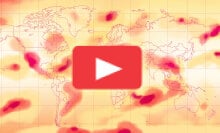Have you thanked the oceans lately?
Water can absorb colossal amounts of heat, and Earth's seas soak up over 90 percent of the heat trapped on the planet by human activities, mostly from the burning of primordial fossil fuels that release prodigious amounts of CO2 into the atmosphere. Normal fluctuations in ocean climate patterns, combined with such continuous background warming, is largely what's now driving anomalously high, or extreme, sea surface temperatures around the globe.
Without our ocean absorbing the lion’s share of excess heat, the land, ice, and atmosphere would have warmed more, leading to further intensified heat waves, droughts, deluges, and other extremes.
"Every time we wake in the morning, we should be saying thanks to the ocean for doing its job," Paul Durack, an oceanographer at the Lawrence Livermore National Laboratory who researches the ocean and its role in global climate variability and change, told Mashable. "The global ocean provides a key climate service." (Of course, this comes at a cost to the oceans and the life dwelling there, too. The bill always comes, as Hemingway sagely wrote.)
Between 2010 and 2020, the ocean absorbed (roughly) the equivalent amount of energy released when detonating a Tsar Bomba — the most powerful nuclear bomb ever detonated — once every 10 minutes for 10 years. It's an unfathomable number.
So, when the already warming oceans get an additional kick from natural, oscillating climate patterns, like the warm El Niño phase in the Pacific Ocean, ocean temperatures reach levels far warmer than usual, which can mean over 2 degrees Fahrenheit — which is a lot for the ocean. In the map below, for example, you can see intense shades of red, signifying above-normal temperatures compared to ocean temperatures measured between 1971 and 2000.
"Every time we wake in the morning, we should be saying thanks to the ocean for doing its job."
As the oceans continue to warm, so too will the entire climate system, with the extreme events increasing in intensities and regularity.
"It’s very likely that the enhancing temperature anomalies will continue to increase," Durack explained. "The background warming for the entire globe continues to accumulate decade after decade, an unrelenting pattern that has been consistent for more than 70 years."


What's warming the oceans
Heat waves on land aren't caused by climate change — but climate change amplifies heat waves and makes them worse. A similar thing is happening in at least two prominent ocean basins, the Pacific and Atlantic.
In the Pacific, a powerful ocean pattern has returned. "Right now there's a developing El Niño happening," Gerald Meehl, a senior scientist at the National Center for Atmospheric Research who studies El Niño and global climate, among other topics, told Mashable.
El Niño is part of a normal fluctuating pattern in the equatorial Pacific Ocean, wherein warm water rises to the surface. This expansive warm region ultimately impacts weather across the globe, such as bringing wetter conditions to the southern U.S., and drier conditions in the north.
The sea surface anomalies can be striking, particularly during a stronger El Niño that's boosted by rising background warming. "As the average temperatures in the ocean warm up and you add an El Niño, then you get these real big hot spots," Meehl explained, noting some hot spots have dire impacts on coral reefs, causing some reefs to die.
See the stark Pacific warming for yourself:

Tweet may have been deleted
Tweet may have been deleted
Elsewhere, exceptional warming in the Atlantic is likely caused by a number of factors, also boosted by background warming, that aren't yet certain. The Atlantic warming is really striking, particularly a pivotal zone off of Africa called the Atlantic Main Development Region, where many tropical storms and hurricanes often start:
Tweet may have been deleted
Tweet may have been deleted
What's going on? Some ocean scientists speculate that weaker winds may have slowed down a process that brings cooler northern waters down into the Atlantic. What's more, Saharan dust often blows across the Atlantic, which has a cooling effect on the ocean surface. Yet dust blowing across the ocean has been reduced this year. Other factors could be at play, too, like a longer-term warming phase in the Atlantic, called the Atlantic Multi-Decadal Oscillation, or AMO, Meehl noted.
Want more science and tech news delivered straight to your inbox? Sign up for Mashable's Light Speed newsletter today.
Whatever the ultimate confluence of causes, the big picture is clear. Earth's oceans are warming, and at times this warming will fluctuate to large-scale extremes. These events aren't going away, because ocean heating shows no signs of abating.
"The amount of heat going into the ocean continues to increase," Durack said.































